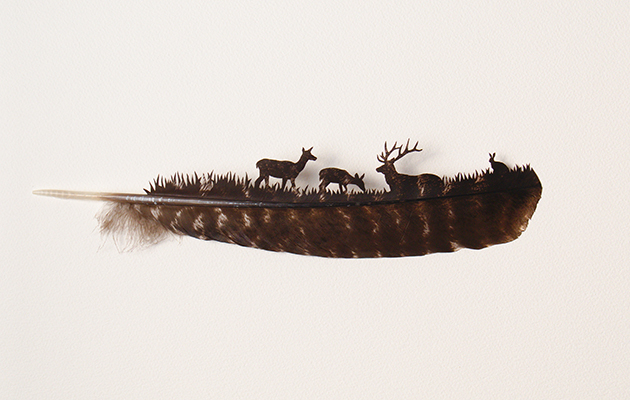The beauty of a single pheasant’s feather caught Nick Orr’s eye — and inspired him to produce something unique, as Janet Menzies discovers
The work of Nick Orr encourages us to see familiar scenes in an entirely new way – a whole day’s shooting in a single feather for example, as Janet Menzies discovers.
For more sporting artists, discover why the great equestrian artists have enduring and universal appeal. And James Wild tells the stories of animals in the world today using sculpture and scrap metal.
NICK ORR
The art of the miniaturist invites us to look at the familiar in a new way by reimagining it on a different scale. In that tradition, Nick Orr’s work captures a whole day’s shooting in a single feather from one bird.
This extraordinary inversion of the beauty of birds in flight expressed microscopically through sculpting a sole flight feather came about by chance. Orr explains: “I pick up on 40 or 50 days a year and process the birds. One day I was breasting out a pheasant and my daughter asked for some feathers. It made me look at them and see how beautiful they were and I thought what a waste not to create something with them.”

A minutely detailed hunting scene.
Having had his 10% of inspiration, Orr now had to go through 90% of perspiration to find a way to work with feathers. “I played around with various ideas and nothing really worked, and I was holding a bunch and started cutting them to shape and to my surprise they didn’t fall apart. I discovered that the barbs on the feather act like Velcro to keep its structure.”
Orr’s whole family set out on the quest to perfect a feather-sculpting process. “We were getting all the feathers we could — even roadkill. I raided the fly-tying box and my brother, who is a doctor, sent me some scalpels, which made the carving a lot easier. But not all feathers are suitable – pheasants’ feathers are not broad enough. In the end, the first successful one was actually on a crow’s primary flight feather.”
Orr had now found his medium but the technical difficulties of his chosen form are unrelenting. “It is as difficult to design the feather as it is to cut it out. The feather is my canvas and it is such a small canvas to work on – less than 3cm — and a very particular shape. Everything I depict must fit into that so I have to overcome that in my composition, which has to be very horizontal. I was trying to do a man with his dog, which is more a portrait shape. I had to use both sides of the feather and the whole thing fell apart.”
Since each feather picture takes “an eternity” to make, and Orr currently has a six-month waiting list, the loss of a feather is a minor disaster. “I have inflicted this problem on myself,” he admits. “It is ridiculously hard, and I am perfectionist about it.”
THE PERFECT FEATHER
Orr’s growing obsession with the perfect feather is spreading to the shoots where he picks up. He admits: “We were shooting greylag geese one day and they have wonderful feathers, so I was just desperate for the dogs not to pick them up by the wings.
“I see birds so differently now. Before I would just put the birds on the back of the game cart but now I see the feathers first and then see the bird. You make a whole different connection. I watch the birds fly, and I want to see really closely how they use their wings. When I am out on a shoot and standing watching the drive, I see the scene as a picture, thinking about how I can recreate it on a feather.”

One of Nick Orr’s feather sculptures, depicting red deer and a rabbit.
Each individual feather is treated differently, with the feather itself playing a major part in the design of the eventual image. “The primary flight feathers are the best. Once I have an idea for a picture, I will start to sketch an overall outline on paper, at the same time as thinking about how it will fit a particular feather.”
One of Orr’s unforeseen problems has been running out of suitable feathers, and he sometimes has to import from the United States. “I love the bronze turkey feathers,” he says. “As well as being strong and good to carve, they are different every time. With many bird species, the colouration of the feathers is predictable — like mallard — but with turkey they have all sorts of patterns of bars and colours. I love the idea that I take a feather from a bird that most people think of as the ugliest on the planet and turn it into something beautiful.”
American frontiersman Davy Crockett would have been delighted; he considered the bird to be America’s most admirable. And that’s at the heart of Orr’s work — to make us see what we normally miss.
For additional information about Nick Orr, and to view more of his art, visit: visit nickorr.art





